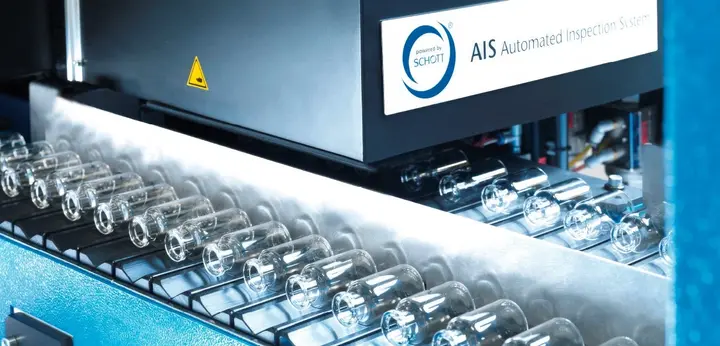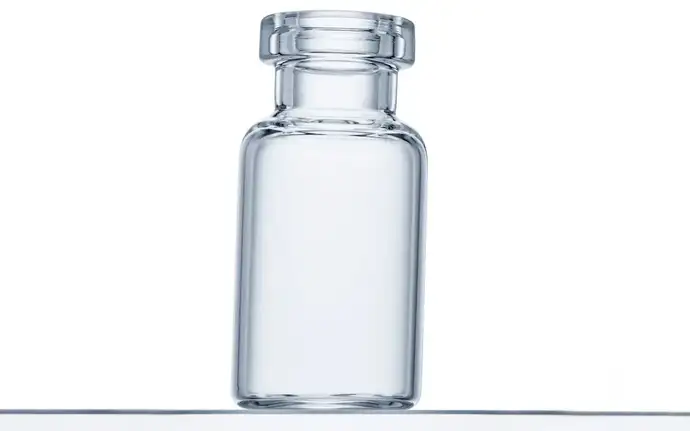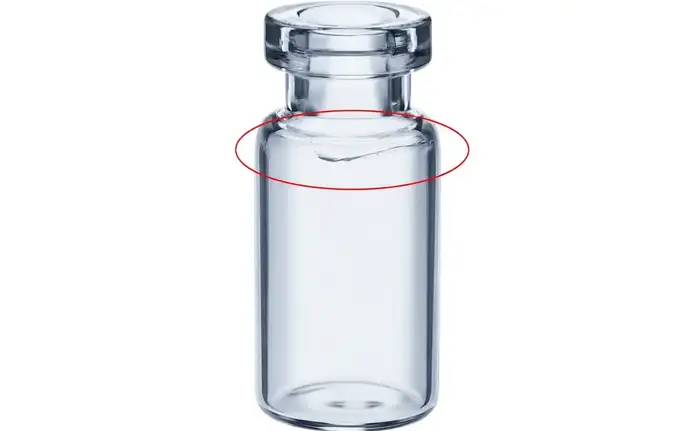
Improving pharmaceutical container quality with automated visual inspection systems
Inspection is essential in the pharmaceutical industry to ensure the quality and safety of medicines. In finished parenteral dosage forms, such as filled vials, inspection systems for pharmaceuticals are used to detect defects or contamination in the primary container, closure, and packaging. As a crucial part of pharmaceutical quality assurance, this inspection process helps protect the health of patients and ensure compliance with legal regulations.
Automated visual inspection systems are also used to inspect the quality of empty containers as part of the container production process. This examination ensures that only high-quality containers are sent to the fill-and-finish site.
What are visual inspection systems?
A visual inspection system uses optical sensors, illumination, and magnification to analyze the appearance of objects and detect defects. An automatic visual inspection system removes the risk of human error by replacing manual handling of the objects and by using advanced image capture and analysis. Artificial intelligence (AI) has led to further advances in visual inspection solutions with increasingly accurate detection capabilities. At SCHOTT Pharma, an automated dimensional inspection system measures critical empty-container product dimensions, and another automated visual inspection system checks for cosmetic defects in the container’s surface to ensure container product quality that meets customer specifications. In addition to quality control, data from the inspection systems are also used for continuously improving the container production process.
Automated visual inspection systems can be customized to meet specific requirements in equipment characteristics, such as the type of optical technology, magnification, lighting, data recording, level of automation, environmental data adaptation, adaptability, and cost.
Measures of quality of a pharmaceutical inspection system include the system resolution, the number of evaluated images, and the robustness of the measurement methods regarding small shape deviations. Ease of calibration and reproducible system settings are additional factors. For visual inspection equipment that is evaluating types of defects (e.g., scratch, particle), other considerations include the area that is inspected, the number of defect classes, the level of defect detection, and accuracy and reproducibility of defect classification.
Visual inspection systems—whether manual or automated—can make two types of errors in identifying defects. Type I error or “False Rejection Rate” (FRR) is the probability that a defect-free container will be rejected by the inspection system. Unnecessary rejects add to production cost. Type II error or “False Acceptance Rate” (FAR) is the likelihood that the system does not recognize or detect a defect. In a pharmaceutical inspection system, where it is of utmost importance that defective containers are rejected, it is important to minimize FAR. When setting up pharmaceutical inspection equipment, it is important to find an appropriate balance of FRR and FAR to achieve an adequate level of security.
Why is the inspection of an empty container prior to filling so important?
Inspecting empty containers during and after production is a crucial step for SCHOTT Pharma. This inspection ensures that the incoming containers at our customers' fill-and-finish sites are as accurate as possible from a dimensional perspective and as flawless as possible from a cosmetic perspective.
Accurate dimensions are especially important for smooth fill-and-finish operations. The visual inspection equipment automatically measures each inspection dimension—including height, heel radius, bottom stamp (i.e., footprint), bottom depth, and wall thickness, as well as the dimensions of the shoulder, neck, and flange—and compares it to the specification. Height variations, for example, can increase the risk of errors during closing and may compromise container closure integrity (CCI). The heel radius greatly affects vial movement on the filling line, especially when there are uneven surfaces. The bottom stamp and bottom depth are crucial for the stability of the vial. Hence, a vial that does not have accurate dimensions can result in severe problems during filling or post-fill operations.

Visual inspection equipment measures each inspection dimension to ensure that each vial meets specifications. In this image, out-of-specification perpendicularity, an excessive skew of the vial, may affect container closure integrity.
The term "cosmetic” is not just a nice appearance or optional feature. Rather, at SCHOTT Pharma, the cosmetic inspection is the crucial final visual inspection step that scans each container to identify and classify a range of defects, such as surface scratches, airlines, or scuffs, as well as critical defects, such as cracks, chips in functional areas, glass particles or inside particulates , which can pose a serious risk to the patient by increasing the risk of contamination and potentially compromising the sterility or functionality of a drug.

The wall penetrating crack in the shoulder area of the vial could result in loss of container closure integrity.
Advanced inspection technologies: Precision, reliability, and AI-driven quality assurance
At SCHOTT Pharma, we are committed to delivering the right products tailored to your specific needs and to the highest quality standards. We meticulously inspect 100% of our containers. Our reliable and robust inspection systems contribute to stable processes with low rejection rates to achieve excellence in all aspects of our operations.
With over two decades of experience in developing and assembling inspection systems for dimensional measurements and cosmetic defect detection, we leverage our extensive knowledge and experience to develop and rigorously qualify and validate our systems.
Our intelligent visual inspection systems independently verify their correct setup, minimizing operator influences, enhancing quality, improving reproducibility, and reducing false rejection rates and false acceptance rates. Each system is equipped with an audit trail, which aligns with pharmaceutical data integrity standards and ensures a clear understanding of any system changes, including when they occurred, who made them, and the justifications behind them. Specific user levels are implemented to prevent system manipulation.
Our visual inspection equipment has very high resolution and high image-capture rate, which allows us to establish tight tolerance limits for critical defects to maintain cost-effectiveness while achieving specific AQLs. Employing AI, including deep learning, for defect classification, we leverage a robust data infrastructure to train models based on real inline data and image capture, utilizing our global production network for continuous improvement. In addition, we calibrate and adjust our visual inspection equipment to achieve standardization and ensure uniform functionality across all our production lines over time. This stable and optimized production process provides consistent container quality from the initial stages of production onward.
The better we are in controlling tight geometries of our drug containment and delivery solutions, the easier and smoother our customers’ fill-and-finish processes are. The better we are at detecting and classifying defects, the better we can steer our process and deliver higher quality to our customers.
Having deployed over 2,500 standardized inspection systems across our global production network, we stand by our commitment to consistently deliver top-notch quality, making SCHOTT Pharma a trusted partner for primary packaging.

Diana Löber
Global Product Manager Specialty Vials & adaptiQ®
Register for the latest news
Stay up-to-date with information about SCHOTT Pharma products and services and register for our newsletter.